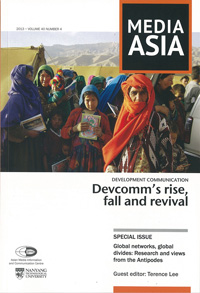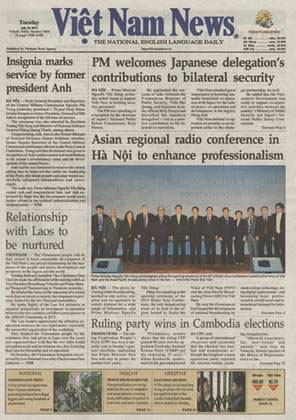
Sep 12, 2013 | Annual Conference, News
 In a video presentation for the UNESCO Emeritus Dialogue session on development communication, UNESCO’s global Director for Freedom of Expression and Media Development, Guy Berger, has said that AMIC is “one of the most esteemed research partners of UNESCO”.
In a video presentation for the UNESCO Emeritus Dialogue session on development communication, UNESCO’s global Director for Freedom of Expression and Media Development, Guy Berger, has said that AMIC is “one of the most esteemed research partners of UNESCO”.
He talked of “new paradigms in development communication” and said that “since the early behaviourists’ concepts and practices of ‘devcom’, there has been dynamic and, indeed, pluralistic development of paradigms in this field.” Dr. Berger said that “these reflect the changing contexts nationally, internationally and technologically”.
The AMIC conference UNESCO Emeritus Dialogue brought together five international experts to look at whether development communication still has a place in the ‘New Asia’.

Aug 23, 2013 | Media Asia
|

|
Subscription
Individual: US$95 / SG$120.00
Subscribe
Institutional: US$200 / SG$250.00
Subscribe
|
Media Asia is a quarterly magazine which serves as an important platform for the exchange of views and information on mass communication in the countries of the Asia-Pacific region. Each issue of the journal has valuable information, views and comments relevant to communication professionals, scholars and laymen.
Editorial
Welcome to the new Media Asia. Since 1974, Media Asia has helped to fulfil AMIC’s mission of nurturing and promoting research and dialogue on media and communication in the region. Entering our fortieth year, Media Asia remains focussed on this role. But, starting with this issue, we will be approaching it in a whole new way.
The most obvious change is in our physical format. We’ve abandoned our old A4 size for this new compact package. Our new dimensions mirror AMIC’s other journal, the Asian Journal of Communication, to emphasise the complementary roles that we play.
It is between the covers that you’ll find the most significant changes. The core of this journal will remain: In each issue, we will still publish several original scholarly research articles blind-refereed by experts in the field. Media Asia’s Research section leans towards empirical studies with a fairly direct impact on practical challenges in Asian media and communication. In line with this continuity, Sundeep Muppidi remains in charge of our research section.
In addition, the new Media Asia contains substantial new sections highlighting current ideas, trends and concerns. Each issue starts with in-depth, journalistic reportage, a feature article analysing a major topic of contemporary interest. In our insights pages, authoritative thinkers and leading practitioners share their opinions on key issues. There is also a section highlighting noteworthy works. Here, we’ll review not only books but also relevant online reports, documentary films and other resources that merit your attention.
We are also excited about our new casefile section. Despite the huge growth of Asian media and communication activities and education, there is a crying need for well-written, easily accessible Asian case studies to use in teaching and research. Media Asia will do its part to help fill the gap.
All thesechanges are guided by our assessment of the strengths and limitations of conventional academic journals. Most journals are dedicated to showcasing the fruits of scholarly work, in the form of peer-reviewed research articles. But, this is only one part of the life cycle of scholarly inquiry. Before new findings are ready for harvesting, the soil has to be tilled and seeded with the right questions. And, after research is published, we need to take stock of how new knowledge is being used on the ground.
We’d like to think of the new Media Asia as contributing to this wider ecosystem. We aim to serve readers who want to harness reliable research and credible, critical insights in order to address contemporary media and communication challenges in Asia. We want to connect researchers, educators, students, practitioners and policymakers, by publishing not only the new findings contained in research articles, but also signposting new directions for research and flagging pertinent questions.
Of course, we will be only as good as the contributions we receive. Please consider Media Asia as an outlet for your research, following the submission guidelines on page 96. If you are interested in contributing to our other sections – Insights, Casefile and Noteworthy – please refer to www.mediaasia.info for more details.
Thank you.
Cherian George
Chief Editor, Media Asia

Jul 12, 2013 | News
 The Prime Minister of Vietnam has called on radio broadcasters to be more dynamic, creative and co-operative to meet the increasing demands of society.
The Prime Minister of Vietnam has called on radio broadcasters to be more dynamic, creative and co-operative to meet the increasing demands of society.
Mr. Nguyen Tan Dung was speaking at the opening ceremony of the RadioAsia 2013 conference in Hanoi. The conference theme was Radio and Social Media: Where to Next?
“Digital technology and the booming social media have given the public greater access to diverse sources of information” he said. The Prime Minister noted that this is “gradually changing the media context in each nation and the world over”.
In his opening address, the President of Radio the Voice of Vietnam (VOV), Mr. Nguyen Dang Tien, said that VOV “has adopted the current trend and made good use of opportunities offered by social networks to diversify its programming”. He reminded delegates that VOV is the only national media organization in Vietnam with four media platforms- radio, television, print and on-line.
Also speaking at the opening ceremony, AMIC’s Secretary-General, Assoc. Prof. Martin Hadlow, said that radio still had a vital role in society. “The messages it carries are understood by all, even those who cannot read or write” he said, “and radio brings life-long educational opportunities, life-saving information, culture and entertainment to individuals no matter where they are, or what they are doing”.
The Secretary-General of the Asia-Pacific Broadcasting Union (ABU), Dr. Javad Mottaghi, told delegates that radio in a digital age “is going through a watershed change, with digital radio providing many possibilities for new content applications, data based services, graphics and still pictures”.
Digital technologies and the impact of social media on radio broadcasting were key issues discussed at RadioAsia, the region’s premier conference dedicated to the medium. The three day event, which brought together several hundred delegates and speakers, was hosted by Radio the Voice of Vietnam and co-organised by AMIC, the ABU and VOV.
Jul 9, 2013 | Annual Conference
The full programme for this year’s 22nd AMIC international conference which was held in Yogyakarta (4th-7th July) is still available here in pdf.
More than 250 paper presenters, a record for AMIC, participated in parallel and plenary sessions at the four-day event. Conference delegates came from some 24 countries across the world.
AMIC’s premier annual event was hosted by Universitas Gadjah Mada and was held at the Melia Purosani Hotel in Yogyakarta.

 In a video presentation for the UNESCO Emeritus Dialogue session on development communication, UNESCO’s global Director for Freedom of Expression and Media Development, Guy Berger, has said that AMIC is “one of the most esteemed research partners of UNESCO”.
In a video presentation for the UNESCO Emeritus Dialogue session on development communication, UNESCO’s global Director for Freedom of Expression and Media Development, Guy Berger, has said that AMIC is “one of the most esteemed research partners of UNESCO”.



 PAKISTAN
PAKISTAN 
 The Prime Minister of Vietnam has called on radio broadcasters to be more dynamic, creative and co-operative to meet the increasing demands of society.
The Prime Minister of Vietnam has called on radio broadcasters to be more dynamic, creative and co-operative to meet the increasing demands of society.